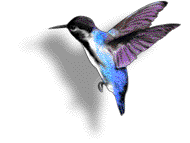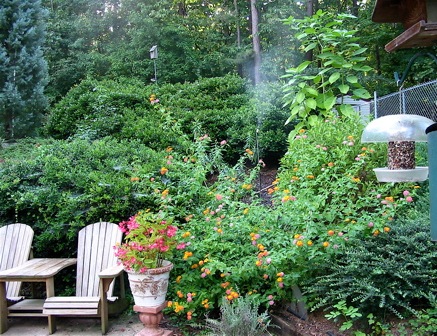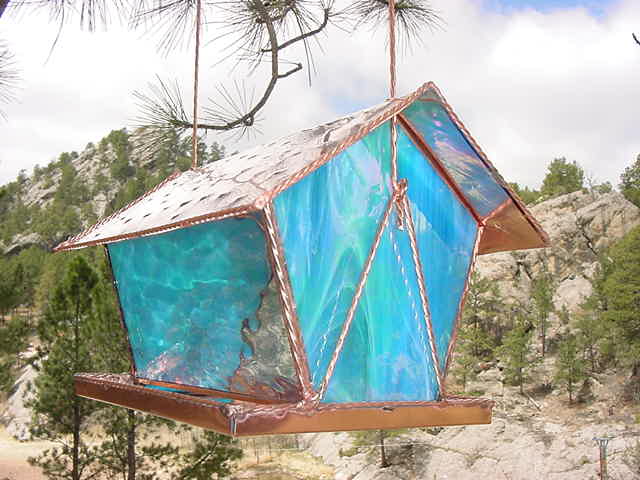-
Time to Dust Off those hummingbird feeders
 The great hummingbird migration has begun!
The great hummingbird migration has begun!Now is the time to get your hummingbird feeders out from storage and give them a good cleaning for the upcoming season. Plain hot water works, even if you send them through the dishwater, be sure to rinse them thoroughly to remove any residue. Along the Gulf of Mexico, Ruby Throats have started to claim territories, with other species following close behind.
Hummingbird season is an exciting one for many backyard birders, as these little sprites tend to provide some mesmerizing entertainment. Many folks could just sit and watch hummingbirds’ shenanigans for hours on end. Aside from the sugar water in hummingbird feeders, moving water is a very big attraction for them. Bathing, drinking and playing in birdbath fountains or bubblers comes naturally for hummers – they’re drawn to it like a magnet.
 If you’re looking to attract more hummers, but already have enough hummingbird feeders, consider adding moving water to your landscape. Leaf misters for instance, are wildly popular among hummingbirds and butterflies as well. In the scolding heat of summer, the gentle mist is a most welcomed addition for many local wildlife species. Leaf misters may be installed in a variety of fashions. Ours stands upright in the garden twisted around a simple plant stake.
If you’re looking to attract more hummers, but already have enough hummingbird feeders, consider adding moving water to your landscape. Leaf misters for instance, are wildly popular among hummingbirds and butterflies as well. In the scolding heat of summer, the gentle mist is a most welcomed addition for many local wildlife species. Leaf misters may be installed in a variety of fashions. Ours stands upright in the garden twisted around a simple plant stake.Treat your hummingbirds to a fun water feature this season and you’ll be rewarded by increased numbers and some fascinating activity and behaviors from the little guys!
Oh yeah… maybe this is the season to try making your own nectar too. It’s really quite simple and only takes a few minutes. Here’s the recipe: one part plain table sugar (cane) to four parts water. That’s it! Never use anything other than pure cane sugar (white table sugar) as it’s harmful to hummingbirds. There’s really no need to boil the water, we boil one cup simply to dissolve the sugar quicker and more effectively. If you do boil the water, be sure it has cooled before filling your hummingbird feeders. Store extra nectar in the fridge for up to two weeks. Now wasn’t that easy?
-
handsome hopper bird feeders
 In order to accommodate more birds, we usually add more feeders. This is probably why our yard now hosts around twenty-some feeders… it’s a chore keeping up too.
In order to accommodate more birds, we usually add more feeders. This is probably why our yard now hosts around twenty-some feeders… it’s a chore keeping up too.If you’re starting with your first bird feeder, or just prefer keeping it to a minimum, then hopper bird feeders are a great choice. They’ll hold different seed mixes so you can experiment and see what works best, and they usually offer lots of perching space for multiple birds to dine at once. Hopper Bird Feeders tend to have a larger seed capacity than tube style feeders as well, so you spend less time filling and more time watching.
This handsome hopper is hand crafted in cedar, with meticulous workmanship and quality materials. It may be more expensive than the hopper bird feeders found at “big box” stores, but it will outlast them by many years. Plus this is an individual artist’s work – their mark and TLC have gone into the making, creating a piece to enjoy and admire for many seasons to come.

Another handsome hopper feeder is this stained glass and copper beauty. Hand crafted in the most beautiful hues, quality hopper bird feeders like these add an interesting focal point in any garden or landscape setting. Again, the generous perching area will accommodate several birds feeding at once.
Even if you’d like to keep the number of feeders to a minimum, you can still attract many more species by offering fresh water. It really is the single, most effective way to entice birds to your yard. Definitely consider adding a bird bath, be it hanging, pedestal, deck-mounted, or a ground bath, you’ll be amazed at the new visitors you’ll see!
-
some very wild bird feeders indeed
 Since backyard birding has become such a popular hobby over the last few years, the array of functional products has pretty much exploded. Artisans and smaller companies are offering hand crafted wares like wild bird feeders, birdhouses and cool bird baths in a myriad of materials. Copper, vinyl, stoneware and ceramics are those materials with durability to last a lifetime. And unlike wood… the squirrels can not chew them to pieces!
Since backyard birding has become such a popular hobby over the last few years, the array of functional products has pretty much exploded. Artisans and smaller companies are offering hand crafted wares like wild bird feeders, birdhouses and cool bird baths in a myriad of materials. Copper, vinyl, stoneware and ceramics are those materials with durability to last a lifetime. And unlike wood… the squirrels can not chew them to pieces!This solid copper bird feeder with unusual design is actually quite beneficial. The large hat-like roof not only protects seed and birds from the elements, but also acts like a baffle to deter squirrels. In two sizes, this gorgeous copper feeder will weather over time to a lovely patina finish, and it’s an awesome addition to any garden or landscape setting.

The retro is new breed of wild bird feeders with it’s groovy space ship design. Made in Germany, this quality feeder has a large seed capacity which stays protected from elements in the encased seed wall. In vibrant raspberry, lime or white, these wild bird feeders are totally fun and functional.
 And of course, Mr. Cool Cat is a stoneware feeder with a tube-like function. Squirrels will never dig their teeth into this weatherproof stoneware, and he’s n absolute hoot to watch feathered friends perched at his mouth enjoying a meal! In black or tan to resemble your favorite feline, these wild bird feeders are a unique addition to any environment… and bird love them too!
And of course, Mr. Cool Cat is a stoneware feeder with a tube-like function. Squirrels will never dig their teeth into this weatherproof stoneware, and he’s n absolute hoot to watch feathered friends perched at his mouth enjoying a meal! In black or tan to resemble your favorite feline, these wild bird feeders are a unique addition to any environment… and bird love them too!With buds popping up from the ground, and buds starting to bloom, we know spring is just around the corner. This is a great time for spruce up in the yard. Please remember to clean out birdhouses in preparation for new visitors, and dispose of the nest in the trash or a good distance from the house as old nests will attract predators. Wild bird feeders should be cleaned periodically to remove mold and bacteria thus preventing the spread of disease. Scrub with a simple bleach solution of 1 to 10 parts water, and rinse thoroughly. This works just as effectively s any commercial bird feeder cleaning sprays.
Welcome spring and happy birding!
